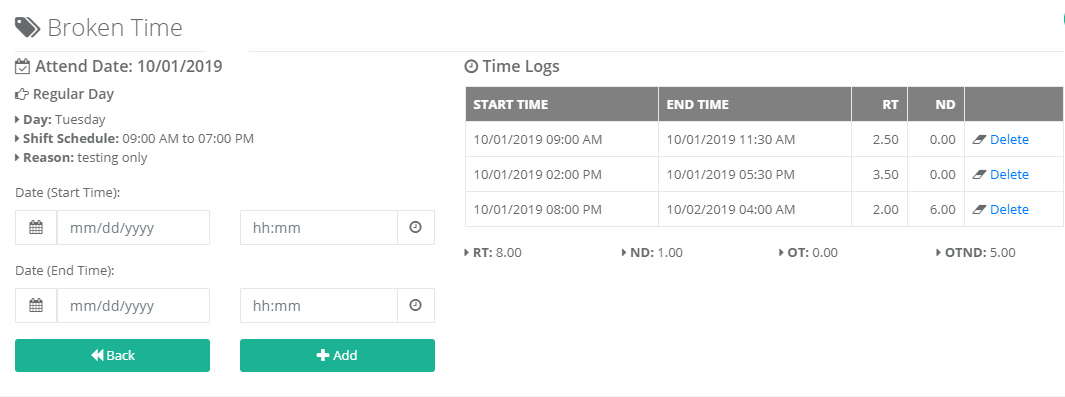Broken Time Work Schedule Filing
Broken time refers to a work schedule where an employee's total working hours are split into multiple periods throughout the day, rather than being continuous. This arrangement typically includes breaks, personal time, or multiple shifts within a single day. Managing broken time is crucial in the timekeeping process to ensure that employees are accurately compensated for the hours worked, including any adjustments for breaks or unpaid periods, and to maintain compliance with labor laws.

Key Element
-
Definition and Types of Broken Time:
- Split Shifts: Employees work in two or more separate shifts within the same day. For example, an employee may work from 9:00 AM to 12:00 PM, take a break, and then return from 3:00 PM to 6:00 PM.
- Intermittent Hours: Employees may work for a few hours at different intervals during the day, often due to personal reasons or operational needs (e.g., working a few hours in the morning and a few hours in the evening).
- Unpaid Breaks: Employees may have unpaid breaks (lunch or personal time), which can divide their workday into multiple periods.
-
Timekeeping Process for Broken Time:
- Recording Hours: Properly tracking broken time is essential. Timekeeping systems must accurately capture when an employee starts and ends each period of work, including breaks, to ensure precise calculation of paid and unpaid time.
- Breaks and Rest Periods: Breaks (e.g., lunch breaks) are often subtracted from the total work hours, depending on company policy and labor laws. Timekeeping systems differentiate between paid working time and unpaid break time.
- Tracking Total Hours: The total work time for an employee with broken time must be computed by aggregating all the separate periods of work, ensuring that the total number of hours worked matches what is recorded in the system.
-
Overtime Considerations:
- If broken time results in the employee working more than their standard hours (e.g., exceeding 40 hours per week), overtime calculations must be made according to the company’s pay policies and labor regulations.
- Employers need to ensure that broken time does not inadvertently lead to miscalculations, such as counting breaks as work hours, or failing to account for overtime work after extended shifts.
-
Compliance with Labor Laws:
- Rest Periods: Many jurisdictions have regulations regarding the minimum length of breaks that employees are entitled to during their shifts. Broken time policies must ensure that these regulations are met.
- Maximum Hours: In some cases, working broken time might affect the total number of hours employees are allowed to work within a day or week. Employers must ensure that the total working time does not violate laws governing maximum hours and mandatory rest periods.
-
Employee and Payroll Considerations:
- Accurate Compensation: Employees must be paid accurately for the total hours worked, minus any legally mandated unpaid breaks or time off. A well-managed broken time system ensures employees are not underpaid or overpaid due to inaccurate time tracking.
- Shift Flexibility: Broken time may be used to offer employees flexibility in their work schedule, making it easier to accommodate personal needs or ensure optimal coverage during peak hours.
-
Challenges and Issues:
- Complexity in Time Tracking: Broken time can introduce complexity into timekeeping systems, requiring accurate tracking of multiple periods within a day. Manual systems may be prone to errors, while automated systems need to be configured to handle such scenarios properly.
- Employee Dissatisfaction: If not managed properly, broken time can lead to dissatisfaction among employees due to the perceived inconvenience or reduced rest time between shifts.
- Compliance Risk: Improper handling of broken time (e.g., failing to deduct unpaid breaks or miscalculating overtime) can lead to legal risks or disputes over pay.
-
Automation and Technology:
- Many companies use automated timekeeping systems that can efficiently handle broken time scenarios. These systems can track multiple periods of work, accurately calculate total hours worked, deduct breaks, and ensure compliance with labor laws.
- Integration with payroll systems ensures that any adjustments for broken time, including overtime pay and deductions for breaks, are accurately reflected in employees' compensation.
Benefits:
- Flexibility: Broken time can offer employees more flexibility in their work schedules, which can improve work-life balance.
- Operational Efficiency: For companies with variable work demands, broken time scheduling allows for more efficient use of workforce resources.
- Cost Efficiency: By optimizing work hours and covering multiple shifts, employers can reduce labor costs without compromising service.
Challenges:
- Tracking Accuracy: Broken time schedules require precise time tracking to avoid errors in payroll, such as incorrect calculation of total hours or unpaid breaks.
- Legal Compliance: Employers must ensure that broken time schedules comply with labor laws governing rest periods, overtime, and maximum working hours.
In summary, managing broken time in the timekeeping process is essential for accurate tracking of work hours, compliance with labor laws, and proper compensation. With the right systems and processes, companies can ensure that employees are paid correctly, while maintaining operational flexibility and efficiency.
ULTRA LOTTO 6/58
- Draw Date: 09/16/2025
- Result: 34-24-32-01-27-03
- Price: Php 49,500,000.00
- Winner: 0
GRAND LOTTO 6/55
- Draw Date: 09/17/2025
- Result: 41-44-40-09-26-49
- Price: Php 161,835,217.60
- Winner: 0
SUPER LOTTO 6/49
- Draw Date: 09/16/2025
- Result: 34-37-41-48-46-33
- Price: Php 40,458,594.00
- Winner: 0
MEGA LOTTO 6/45
- Draw Date: 09/17/2025
- Result: 17-09-06-38-16-36
- Price: Php 31,742,677.40
- Winner: 0
LOTTO 6/42
- Draw Date: 09/16/2025
- Result: 20-18-06-42-10-21
- Price: Php 12,348,288.80
- Winner: 0
6 Digit
- Draw Date: 09/16/2025
- Result: 1-3-4-7-3-7
- Price: Php 1,510,611.60
- Winner: 0
4 Digit
- Draw Date: 09/17/2025
- Result: 9-7-3-8
- Price: Php 10,000.00
- Winner: n/a
SWERTRES RESULTS
- Draw Date: 09/17/2025
- 2PM: 8-0-9
- 5PM: 6-4-5
- 9PM: 3-1-0
EZ2 RESULTS
- Draw Date: 09/17/2025
- 2PM: 15-26
- 5PM: 25-02
- 9PM: 01-02